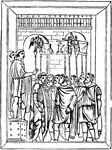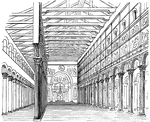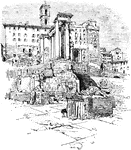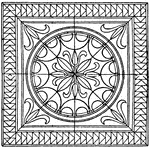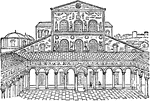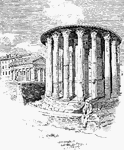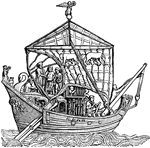
A Roman Standard Bearer
"From a gravestone of the first century A.D. The standard consists of a spear crowned with a wreath,…

Roman Standards
Staffs carried by Roman legions to show who they were and what rank in the army they held.

A Roman Temple
"The best preserved of Roman temples. Located at Nimes in southern France, where it is known as La Maison…

Roman Tent
"The Roman soldiers seem to have used two sorts of tents, one, a tent proper, of canvas or some analogous…

The Wall of Rome
"Constructed by Aurelian and rebuilt by Honorius. The material is concrete faced with brick; thickness,…
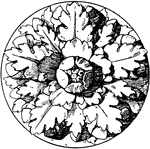
Roman Rosette
The Roman rosette is an artificial rose with five divisions. It is typically found on furniture, gates,…
Caesar Crossing the Rubicon
An image of Julius Caesar and his army crossing the Rubicon River, which is located in northeastern…
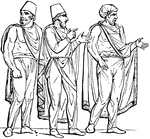
Sagum
"The sagum was open in the front, and usually fastened across the shoulders by a clasp. The form of…
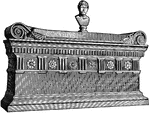
Sarcophagus of Scipio Barbatus
Sarcophagus of Lucius Cornelius Scipio Barbatus, an elected Roman consul in 298 BC.
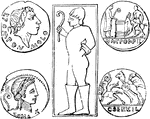
Sculpture and coins
"The figure in the middle of the following illustration is from a most ancient specimen of Etruscan…
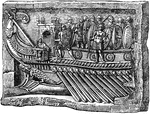
Prow of a Roman War Ship
"The representation shows the arrangement of the tiers or oars in a two-banked ship. In just what way…

A Slave's Collar
"A runaway slave, if recaptured, was sometimes compelled to wear a metal collar riveted about his neck."—Webster,…

Roman Sphinx
The Roman Sphinx is the bust of a woman with wings and the body of a lion. This design was found in…
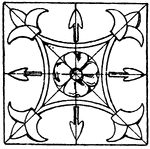
Roman Square Panel
The Roman square panels is an 1879 bas-relief design found near the Tiber river in Rome, Italy. This…
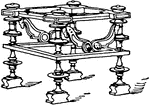
Roman Bisellium Stool
The Roman Bisellium Stool also called the Roman double stool, was made of bronze but did not have a…
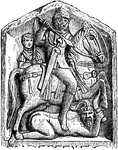
Sueve and Roman Rider
A Roman rider battling a Sueve. Suevi were Germanic people that posed a threat to the Romans.

Suovetaurilia
"The relief pictures an ancient Italian sacrifice of a bull, a ram, and a boar, offered to Mars to secure…
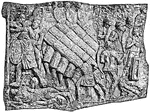
A Testudo
"A relief from the Column of Trajan, Rome. The name testudo, a tortoise (shell), was applied to the…
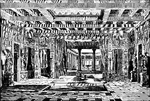
The Interior (Atrium and Peristylium) of Pansa's house at Pompeii, Restored
Illustration of a restored atrium and peristylium of the House of Pansa at Pompeii. The impluvium, pool,…

Tomb of Theodoric at Ravenna
"The two-storied marble structure is capped by an enormous monolith weighing over 300 tons."—Webster,…
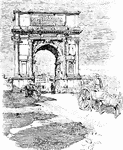
Arch of Titus
"In the time of Trajan, the Arch of titus and the Colossus of Nero (a gilt bronze statue 120 feet high),…
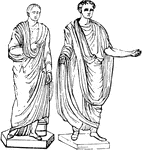
Roman Togas
"The following cuts represent, the first more ancient, and the second the later mode of wearing the…

Roman Sarcophagus Tomb
A coffin or tomb of stone; a kind of stone chest, generally more or less ornamented for receiving a…

Gallic Torques
Gallic Torques were heavy necklaces of braided metal. Gauls carried their wealth in the form of Gold…

Interior of Trajan's Bascilica
"Interior view of Trajan's Basilica, as restored by Canina." — Encyclopediia Britannica, 1910

Roman Table Support Trapezophoron
The Roman table support Trapezophoron is a marble design of a lion head and claw.

Roman Table Support Trapezophoron
The Roman table support trapezophoron is a marble design of a Lynx head and claw.
Roman Table Support Trapezophoron
The Roman table support trapezophoron is a marble design of a Lynx head and claw.
Roman Table Support Trapezophoron
The Roman table support Trapezophoron is a marble design of a panther head and claw.

Roman Table Support Trapezophoron
The Roman table support Trapezophoron is a marble design of a panther head and claw.
Roman Table Support Trapezophoron
The Roman table support Trapezophoron is a marble design of a lion head and claw.
